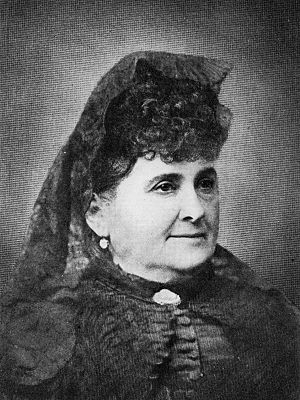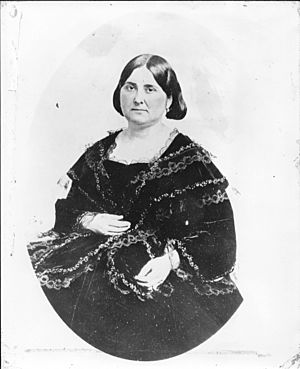Arcadia Bandini de Stearns Baker facts for kids
Quick facts for kids
Arcadia Bandini de Stearns Baker
|
|
|---|---|

Arcadia Bandini de Stearns Baker
|
|
| Born |
Arcadia Bandini
1827 |
| Died | 1912 (aged 84–85) Santa Monica, California, U.S.
|
| Spouse(s) | Abel Stearns, Robert Symington Baker |
| Parent(s) | Juan Bandini and Marie de los Dolores Estudio |
Arcadia Bandini de Stearns Baker (1827–1912) was a very rich and important woman from California. She was known for owning a lot of land and being a big part of the social scene in Los Angeles and later Santa Monica.
Arcadia married two wealthy American men: Abel Stearns and then Colonel Robert S. Baker. Like many Californian women of her time, she helped her husbands connect with the powerful Californio families. She was also a smart businesswoman and a famous hostess, known for throwing amazing parties.
Thanks to her own family's wealth and her husbands' fortunes, Arcadia Bandini de Stearns Baker became incredibly rich. When she died, she was one of the wealthiest women in America. Later in her life, she was called "the great helper of Santa Monica" because she invested a lot in the city and helped it grow. She didn't have any children and didn't leave a will, which led to a big court fight over her money after she passed away.
Contents
Early Life: The Bandini Family
Arcadia Bandini was born in 1827 in San Diego, California. Her parents were Juan Bandini and Marie de los Dolores Estudillo. Her father, Juan, was born in Peru and was known as the "first citizen of San Diego."
The Bandini family home, Casa de Bandini, was the center of San Diego's social life. Their parties and dances were so famous that Juan Bandini was called the "Prince of Hosts."
The Bandinis were also one of the richest families in the area, owning a lot of land. This made Arcadia and her two younger sisters, Ysidora and Josefa, very desirable wives for ambitious men. The three sisters were known as some of the most beautiful women in Alta California.
Juan Bandini supported the American newcomers during the 1846 Bear Flag Revolt. He believed California's future was with America. Arcadia and her sisters even made a U.S. flag from their own clothes and raised it at their father's ranch in 1847.
Marriages
To Abel Stearns
When she was 14, Arcadia Bandini married 43-year-old Abel Stearns. He was an American who had moved from Lunenburg, Massachusetts. Arcadia's father, Juan Bandini, arranged the marriage because he and Stearns were close friends and political allies. Arcadia's younger sister, Ysidora, moved to Los Angeles with her to keep her company.
Stearns became a Mexican citizen and changed to Catholicism so he could own land and do business in Mexican California. He became one of the richest men in Los Angeles. Arcadia's large gift of land (her dowry) added to his wealth.
They lived in a home called El Palacio (The Palace), built in 1859 in Los Angeles. This large adobe house was a major place for Los Angeles high society. They hosted important guests like Commodore Jones and Captain Frémont.
Arcadia Bandini de Stearns, along with her sisters, hosted many grand parties for important Californians and Americans like Stearns. People said that de Stearns Baker "ruled Los Angeles society" during this time.
Abel Stearns was known as a good friend and husband, but he also had a bad temper. He was often away from home and didn't pay a lot of attention to Arcadia. They did not have any children. Stearns died in 1871, at age 72, leaving all his money and land to Arcadia.
To Colonel Robert S. Baker
In 1875, Arcadia married Colonel Robert S. Baker (1826–1894). He was a rich American from Rhode Island. He owned Rancho San Vicente y Santa Monica, where they decided to live. Colonel Baker came to California in 1849 during the Gold Rush. He worked in mining supplies and then in the cattle and sheep business.
He bought Rancho San Vicente y Santa Monica from the Sepulveda family to expand his cattle business. He then moved to Los Angeles, where he met and married Arcadia. Through their marriage, Baker also gained control of the Bandini family's lands, Rancho La Laguna and Rancho La Puente, which further grew his ranching business.
The couple moved to Santa Monica and played a huge part in developing the city. They lived in "Ocean Cottage" near the pier. Arcadia continued to host many important guests and political figures there, just as she had in Los Angeles.
The Bakers did not have children. Colonel Baker died in 1894, leaving his money and property to Arcadia. She continued to live in their home on Ocean Avenue until her death in 1912.
Landowner, Businesswoman, and Helper
Even though she married two American men and California became part of the United States during her lifetime, Arcadia de Stearns Baker reportedly never spoke English. She always did business in Spanish. So, she needed an interpreter. For many years, her husband Abel Stearns helped her with this.
Los Angeles
Much of Los Angeles's business and social life revolved around Abel and Arcadia because of Abel Stearns's large warehouse, "La Casa de San Pedro." This warehouse was one of the four most important trading ports in the West at the time.
Arcadia's name was on all of Abel Stearns's business investments. This meant she shared in his wealth as a business partner, not just as his wife. After Stearns died, Arcadia took over running his businesses.
Even after moving to Santa Monica, Arcadia remained important in Los Angeles society and charity work. In the early 1900s, she was a key source of money and support for women's clubs and their causes. Her wealth and social status made her "the most powerful of all" the elite Californian women. She worked with Los Angeles club women on events like the yearly Fiesta de las Flores.
Santa Monica
Arcadia de Stearns Baker was known as the "godmother of Santa Monica" and a "great helper" because of her ideas and contributions to the city's growth. She helped create the original map for the city's layout, which was very important for Santa Monica's design.
She donated a lot of her land. For example, she gave land to the city of Santa Monica for Palisades Park. She also gave land to the government for a National Home for Disabled Veterans (now the Veterans' Administration). She also donated land to create the first experimental forestry station in the United States, and to schools, churches, and clubs.
In 1879, Arcadia de Stearns Baker bought out her husband Colonel Baker's land and business. She officially became the business partner of John Percival Jones. In 1897, Arcadia and Jones started the Santa Monica Land and Water Company. This company divided and developed about 50,000 acres in West Los Angeles.
Legacy
A grand hotel at 1700 Ocean Avenue, near the Santa Monica pier, was named "The Arcadia Hotel" in honor of Arcadia Bandini de Baker. It opened in 1887 but was torn down in 1909.
On October 18, 1987, a bronze statue was revealed at Palisades Park in Santa Monica. It was made by artist Masahito Sanae. A plaque on the front says:
DEDICATED/TO/ARCADIA BANDINI DE BAKER/1827-1912/FOR HER LOVE AND DEVOTION TO SANTA MONICA AND/GENEROUS CONTRIBUTIONS OF LAND TO BENEFIT/THE PEOPLE AND THE GOVERNMENT OF THE CITY/BY/THE CITY OF SANTA MONICA/BANDIDI FAMILY AND FRIENDS/SANTA MONICA HISTORICAL SOCIETY/MASAHITO SANAE/SCULPTOR/OCTOBER 18, 1987.
Identity
Many important Californians like Arcadia Bandini said they were "Spanish" (not Mexican). This helped them connect with Europe and be seen as white, moving away from the idea of mixed races often linked with Mexico. Marrying white American men, like Abel Stearns and Robert S. Baker, further supported this idea of being white.
Sometimes, this idea of being white or "Spanish" was questioned. For example, a women's club in Los Angeles decided not to allow African American women to join. A clubwoman named Caroline Severance wondered why white Americans socialized with "Italians, Spaniards, and representatives of other dark-skinned races," but not with African Americans. Arcadia de Stearns Baker was very angry to be called "dark-skinned." She refused to take part in the annual Fiesta de Flores in Los Angeles and took back her donation. Other important Californian women followed her lead.
Death and Legal Battle Over Estate
Arcadia Bandini de Stearns Baker died in 1912, at age 85. She was buried between her husbands at Calvary Cemetery, East Los Angeles. About 2,000 people attended her funeral, showing how important she was to the community.
She left behind a huge fortune, estimated to be between $8 and $15 million. Because she did not leave a will, her death started a big court battle over her money and land. Many distant relatives tried to claim the money. In the end, her relatives received most of the estate.
The story of this battle and Arcadia Bandini's generosity was brought up again in a 2011 court case. People supporting homeless veterans sued the Veterans Administration. This was because the VA was renting out a large part of the land Arcadia had given to the government to create a home for disabled veterans. The federal government settled the case, and the Veterans Administration now has to create a plan to find housing for homeless veterans on that land.






